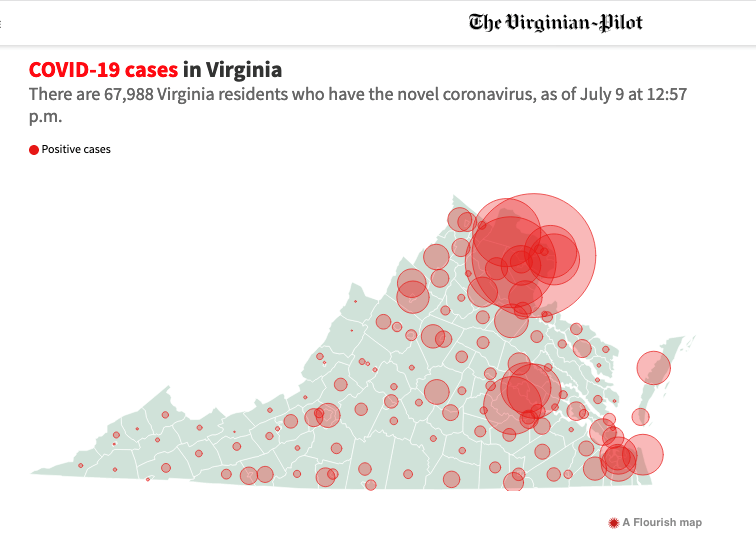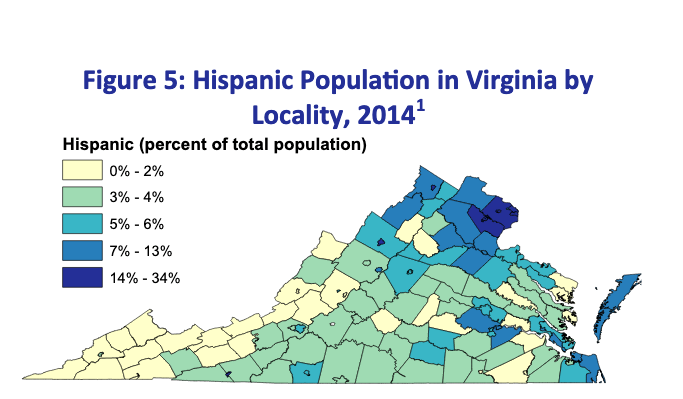Last week Del. Jennifer Carroll Foy, D-Prince William, wrote a letter to Governor Ralph Northam decrying the high rate of COVID-19 infection in Virginia’s Hispanic population. She blamed “longstanding and systemic factors, such as disparate access to information, testing, and treatment.” Jim Bacon responded that Virginia Department of Health (VDH) data did not support Foy’s assertion. But even Bacon took the VDH numbers as an accurate reflection of reality. In truth, VDH “confirmed cases” numbers, which suggest that Hispanics account for 43% of all COVID-19 cases in which race/ethnicity have been identified, are not reliable.
Originally, VDH number crunchers broke down confirmed cases as Black, White, Other, and Unknown. In mid-June they created Latino as a new demographic category, describing it as “Individuals of any race who identify as ‘Hispanic or Latino.’” To create the Latino category, VDH moved 11.3 percentage points from the White cases and 23.6 percentage points from Other and Unknown Race cases. The result: Hispanics accounted for 33.9% of all cases.
Ignoring 16,500 cases in the Unknown category increases the apparent proportion of Black and Latino cases and provides talking points for Del. Foy and the Governor that Latinos have 43% of all cases whose ethnicity was identified.
As can be seen by comparing the maps above and below, the distribution of the Hispanic population within the Commonwealth overlaps with COVID-19 hotspots, exposing more Hispanics to the virus. Also, heavier testing within those hotspots has identified more Hispanic cases. Unless randomized testing is conducted across all racial/ethnic categories using the same protocols, it is impossible to give an accurate estimate of the incidence of the virus within each group.

VDH said, “The percentage of the Hispanic/Latino population varies widely by county, from a low of 0.1% in Cumberland County to a high of 34% in Manassas Park City. … While Virginia’s proportion of Hispanics/Latinos is well under the national average of 17%, it represents a sizable population which is increasing and whose needs should be taken into account in the resource planning process.”
The 2014 Hispanic population was 687,000. In 2018, the number was estimated at almost 813,000, and it has increased since then. As an example, the Hispanic population in Fairfax increased 16.4% in 2019, so it is conceivable statewide the number is closer to or over a million in 2020.
The politics of ethnicity
Governor Northam held a COVID-19 Briefing in Fairfax on June 18, two days after the Virginia Department of Health announced the new breakdown of categories for reporting on COVID-19 which gave Hispanic ethnicity the same weight as race in reports. The briefing was targeted at Hispanics and included several persons who spoke in Spanish. The governor used the opportunity to make political points showing how Virginia and Prince William County are supporting undocumented Hispanics. He quoted a 10% Hispanic population number while he ignored the fact the Census classified Hispanics first within Black or White race numbers and added the Hispanic identification as additional information. With the VDH “Unknown” category hitting 16,500 on July 10, neither the governor nor anyone else can say what the true percentage of cases is for any VDH racial/ethnic category.
But the governor did say, “Clearly, Latino communities are disproportionately affected by this virus. … Latino people are more likely to work in jobs that put them at high risk of contracting the virus. These risk factors are compounded within the Latino undocumented population.” He continued:
Our Medicaid program has worked to make it as easy as possible to enroll if you are eligible … and Medicaid is giving non-citizens extra time if needed to document immigration status when they apply for health coverage. For those who are not documented, but need testing or care, please be assured getting you tested and cared for is our priority. We’re not checking papers at these testing events or at clinics. We just want to help you and your families to be safe and healthy. I also want to acknowledge the action by Prince William county to end its 287-G program in which local law enforcement was collaborating with federal ICE officials and reporting the immigration status of people arrested. I hope this will set a new tone of trust and support with our Latino communities.
Heavy testing in Hispanic communities in Northern Virginia
Jeff McKay, Chairman of the Fairfax County Board of Supervisors at the June 18 briefing described the heavy testing there. “In Fairfax, we recognized this disproportionality from day one of this virus.” He said that the county had given over 69,000 tests already and was averaging over 9,200 tests per week in the Fairfax Health District, with more than 25 sites offering testing.
Fairfax Health District reported 98,282 PCR tests as of July 12, the highest number in the state, almost 42,000 more than Prince William, with the second highest number at 56,529. There probably have been many more cases in other races or ethnicities in other areas of the Commonwealth, but nowhere else has seen this level of testing to know for sure.
The actual numbers for the other health districts range from four districts with 37,000 to 41,000, ten districts with 22,000 to 28,000 tests and 19 districts with 4,527 to under 20,000 tests.
The VDH map of PCR tests highlights areas with 1000+ tests as the most heavily tested, and these areas also overlap the Hispanic population distribution map areas.
On June 14, the Black percentage of all cases was 14%, or 18.7% when omitting the Unknown cases — less than the 2019 census estimate that the Black population in Virginia is 19.9%. As of July 10, the numbers shifted slightly to 15.2% of all cases or 19.9% without the Unknown cases. Could it be that Black COVID-19 statistics no longer appeared disproportionate enough to single them out for press conference attention and the governor wanted to woo another segment of the population? VDH certainly managed to craft the Hispanic numbers for him to do so.
Carol J. Bova is a writer who lives in Mathews County.


Leave a Reply
You must be logged in to post a comment.